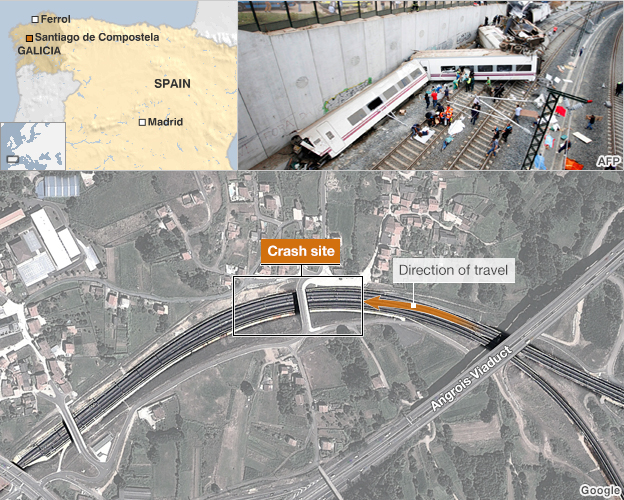![]() The new issue of GuildMag is now online (that is, GuildMag the Guild Wars 2 online magazine, as opposed to the regular website where my weekly column appears). Go to the website to get the details or click the image below to go directly to the front page of the new issue:
The new issue of GuildMag is now online (that is, GuildMag the Guild Wars 2 online magazine, as opposed to the regular website where my weekly column appears). Go to the website to get the details or click the image below to go directly to the front page of the new issue:
July 25, 2013
GuildMag issue 9 now available
Spanish passenger train may have been running at 190 km/h in an 80 km/h zone
The horrific railway crash near Santiago de Compostela that has taken at least 80 lives may have been caused by excessive speed, which this video certainly seems to confirm:
The BBC reports that the engineer may have admitted travelling at a speed more than twice what that curve was rated for:
At least 130 people were taken to hospital after the crash, and 95 are still being treated, health officials say.
The 32 seriously injured include children.
People from several nationalities are among the wounded, including five Americans and one Briton.
[…]
A spokeswoman for the Galicia Supreme Court said the driver, who was slightly injured in the crash, was under investigation.
Named by Spanish media as Francisco Jose Garzon Amo, he is expected to face questioning by police on Thursday.
It was unclear whether anyone else was subject to investigation.
The train’s carriages have been removed from the track by cranes and sent for analysis.
The president of railway firm Renfe, Julio Gomez Pomar, was quoted by El Mundo newspaper as saying the driver, who was aged 52, had 30 years of experience with the company and had been operating trains on the line for more than a year.
He said the train which derailed had no technical problems.
“The train had passed an inspection that same morning. Those trains are inspected every 7,500km… Its maintenance record was perfect,” he told Spanish radio.
But Mr Garzon, who was trapped in the cab after the accident, is quoted as saying moments after the crash that the train had taken the curve at 190 km/h (118mph) despite a speed limit on that section of 80km/h, unidentified investigation sources have told Spanish media.
Update: The Renfe high speed trains use a safety system known as ASFA (Anuncio de Senales y Frenado Automatico or signal notification and automatic braking). The BBC says railway safety experts are confounded that the engineer was even able to exceed the speed limit in the area of the crash:
Sim Harris from Rail News told the BBC he was baffled as to how this could have happened.
“Modern trains have got so many systems on board to stop ‘over speed’ of this extreme kind,” he said.
“The ability of the driver to break the rules in this way is very limited indeed by the on-board systems of the train.”
The most modern train safety systems use equipment on the track and within the driver’s cab to replace traditional signals and control the speed and movement of the train automatically.
With a system such as the European Train Control System (ETCS), a driver would not be able to break the speed limit.
While parts of Spain’s rail network — including a large section of the route the train had travelled from Madrid — do have the ETCS in operation, the curve where Wednesday’s derailment took place relies on a less sophisticated safety system known as ASFA.
ASFA — Anuncio de Senales y Frenado Automatico or signal notification and automatic braking — relies on a series of beacons to communicate with the driver’s cab — so does not have the constant communication of ETCS.
The system gives audio and visual warnings to the driver if speed limits are surpassed, and will step in and brake the train if there is no response from the cab.
Misappropriation of William Lyon Mackenzie
Richard Anderson on a recent attempt to “re-imagine” the real William Lyon Mackenzie:
It seems unlikely that William Lyon Mackenzie was the chillin’ sort of dude. In fact he was a notorious hot-head. Nor was he fond of big government. During his brief and ill-starred rebellion Mackenzie actually had a flag made up with the word LIBERTY written on it. He was a libertarian avant la lettre and would likely be utterly horrified at the size and scope of modern municipal government. For a public sector union to appropriate him as a sort of mascot for “public service” is chutzpah at its finest.
One of the many things that rankled Mackenzie, he was inclined to react strongly to injustice, was tightly knit oligarchies who use government power to fleece the ordinary citizen. In his day they called it the Family Compact. Today we might call it the Liberal-NDP-Government Union Axis. Not as catchy, but again I’m not WLM. I’m omitting the provincial Tories as their haplessness renders them more amusing than contemptible at the moment.
[…]
I haven’t the slightest clue as to Mackenzie’s views on diversity, the Upper Canada of his day was as white as a lily. From the records that have come down to us he seems to have been a fairly enlightened man. What he would have made of Toronto’s demographics we can only guess at. We are on more certain ground as to government providing “assistance to its elderly, infirm and financially disadvantaged.” Mackenzie would almost certainly have opposed government involving itself in such essentially private matters. Those incapable of fending for themselves were the responsibility of the churches, private charities and of last resort the municipal government. Relief for the poor was remarkably stingy both from necessity and principle.
The solution to “poverty” in early Victorian Canada was typically an axe and a few acres of land. There is little indication in the historical record that the rebel of 1837 was some kind of proto-socialist. That CUPE is implying as much is disgraceful.
Hard times for Somalia’s pirates
Strategy Page on the plight of a number of kidnapped ship crews in the hands of Somali pirates and the hard times those pirates are facing themselves:
Somalia is a sad place and one of the saddest tragedies ever is being played out where pirates in the north are holding 40 sailors and several ramshackle ships that no one will pay a ransom for. These are seagoing fishing boats and small freighters owned by small operators with no insurance to cover ransoms and not enough cash, or inclination, to pay what the pirates demand. The negotiators (who work for the pirates) have explained all this to the pirate chiefs, who are facing hard times themselves and stubbornly refuse to face the fact that they will never get anything for these 40 sailors and their ramshackle ships (one of which recently sank at anchor). Just killing the remaining prisoners (some held for three years) and sinking the ships risks retribution from the anti-piracy patrol off shore. Countries the prisoners are from have been pressured to pay ransom, but all of them adhere to the “no negotiating with terrorists” code. There is growing pressure on the pirates to simply release the unwanted prisoners on “humanitarian grounds” and at least get some good press out of this mess. That’s a bitter solution for the pirates, who have not captured a ship that could be ransomed in over a year. Several pirate gangs have disbanded and those still around have shrunk and cut the payroll considerably.
The big time piracy is largely out of business because warship patrols and better security aboard large ships passing Somalia has made it nearly impossible to seize these vessels. Holding ships for ransom only worked initially because Somalia, a state without a government since 1991, provided small ports on the coast of East Africa where pirates could bring the merchant ships they had captured, and keep them there, safe from rescue attempts, until a ransom could be negotiated.
[…]
Pirates usually function on the margins of society, trying to get a cut of the good life in situations where there aren’t many options. This is usually in areas where state control is weakest or absent, in failing and “flailed” states (a flailing state is something like Nigeria, Indonesia, or the Philippines, where the government is managing to just barely keep things together, unlike a failed state such as Somalia, where there isn’t any government at all).
The solution to piracy is essentially on land, where you go into uncontrolled areas and institute some law and order and remove the pirate safe havens. This has been the best approach since the Romans eliminated piracy in the Mediterranean over 2,000 years ago. Trying to tackle piracy just on the maritime end can reduce the incidence of piracy but can’t eliminate it. In the modern world the “land” solution often can’t be implemented. Who wants to put enough troops into Somalia to eliminate piracy? And flailing states are likely to be very sensitive about their sovereignty if you offer to help them control marginal areas.
A new industry has developed that attempts to “pirate proof” ships operating off Somalia. The most successful (and most expensive) technique is to put a small number of armed guards on each ship. That, and warship patrols, has greatly reduced piracy off East Africa (Somalia). But off West Africa (especially the Gulf of Guinea) the piracy threat is growing because pirates have found ways to get more valuables off ships before security forces (police, coast guard, or navy) can show up.
First world blogging problems
I use a few tools to come up with items to post on the blog. The two most useful are Twitter and RSS. I’d been using Google Reader for my RSS needs until it was shut down at the beginning of July, so I switched to The Old Reader and it has been working quite well as a direct Google Reader replacement. Earlier this week, TOR had a server meltdown and multiple failures of drives while attempting to recover. As of this morning, they’re still trying to get back online and (hopefully) recover all the data. Fortunately, I’ve also been testing Newsvibe for RSS, and it’s still working well … but has a different set of feeds than TOR.
My other main tool, Twitter, seems to be having some issues today … or it might just be that my old Twitter client is finally giving up the ghost. I’ve been using the desktop TweetDeck client for years, but I really disliked the “new” version of the tool introduced when TweetDeck was taken over by Twitter itself. Over the last several months, the old client (version 0.38.2) has been slowly losing bits of functionality — for example, sometime in the last week, I lost the ability to send a direct message from Tweetdeck, and earlier this year it became impossible to use the “old” retweet method and more recently to retweet at all.
Today, when I started up the client, it was unable to retrieve any data from earlier this morning. This might be a general issue with the Twitter API or it might be yet another bit of creeping feature-fail. It’s picking up new Twitter posts, but one of the more useful features was that it would also collect tweets from my several lists that had been posted overnight. This morning, only the main feed column in Tweetdeck is being populated, the rest (Mentions, Direct Messages, various list and search columns) are empty.

I may need to shop around for a new Twitter client. Either way, it puts a crimp in my usual blogging habits.





